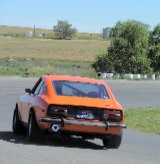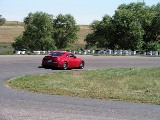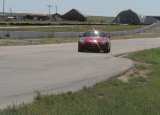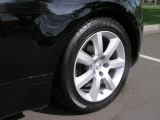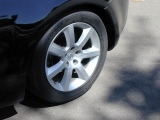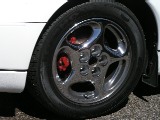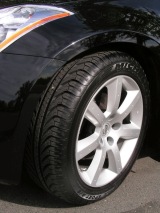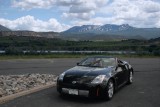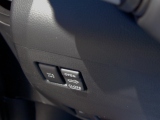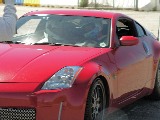
350ZRť An Unofficial
350Z Roadster Resource
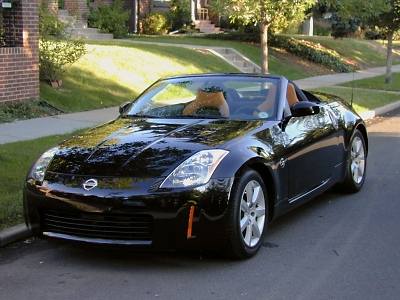
|
On 350ZRť |
"Adventure is inconvenience properly perceived." Llewellyn Thomas
"Places to go, things to do, Porsches to pass..." 350Z showroom banner
"Think of it as a high-performance park bench with a mechanical beauty far exceeding any external good looks." the author
350ZRť Track Day!
"Life is on the wire. Everything else is waiting." Kurt Wallenda
On this page...
 |
On the Track with the Z Car Club of Colorado |
 |
Natural Habitat |
 |
Help for Standard Brakes |
 |
Track Tips |
On the Track with the Z Car Club of Colorado
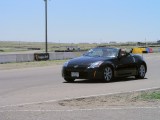 |
Turning into the hairpin at Turn 1 |
Twice now, I've had the good fortune to enter my roadster in ^Z Car Club of Colorado (ZCCC) track days first in June, 2004 and again that September. My reckless youth included a good number of motorcycle track days and even a racing school at Laguna Seca, but these were my first four-wheel attacks on a bona fide road course. To play it safe, I started in the least advanced driver class (D) but moved up to Class C after one heat. Next time, I'll try my hand at Class B. The club's June, 2005 track day won't come a day too soon.
For a $50-85 entry fee depending on membership, ZCCC track days include at least four 20-minute heats at 2nd Creek Raceway near Denver International Airport, usually with 60-90 minutes of car talk and mandatory corner work in between. All marques are welcome, but beware: The tight 9-turn, 1.7-mile course plays to all the 350Z's long suits cornering, torque and braking. Turns 7-9 are 3D enough to keep things interesting.
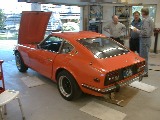 |
Jim []'s 1971 240Z at the mandatory pre-track safety inspection |
Superb organization and
strictly enforced passing rules make for an enviable safety record some
bruised egos, but no
significant injuries in the 14 years ZCCC has been holding track days. Pre-track
safety inspections and Snell-approved helmets are mandatory. Laps are purposely
untimed to keep competitive juices in check, insurance costs down and track fees
affordable. When the green flag falls, you're basically driving against yourself
while sharing the track safely with others trying to do the same.
Numberwise, 300ZX twin turbos and a host of fine older Zs still dominate the
ZCCC, but the 350s are making headway. Of the 40-50 cars entered on our last 2
track days, half a dozen or so were 350Zs, mostly
stock, and they generally did very, very well. My roadster held up its end with no mods other than
engine grounding and tires.
Natural Habitat
Observing and driving the 350Z in its natural habitat the track reveals a core element of the car's nature that responsible driving on public roads can only suggest. Its ability to double as a daily driver is all the more admirable once you've seen it run free.
|
The 350Z is hands down the best handling of
the six Z cars I've owned. As the owner of
a roadster manufactured in July, 2003, I'm happy to have the original
suspension. The "Euro-style" ride introduced in October, 2003 is
a good bit tamer.
After 30 years, those 240Zs are still damn fast. The 350Z has a proud heritage indeed. |
||||
|
Cornering and torque are impressive right out of the box for coupes and roadsters alike. If the latter's rigidity suffers for lack of a hard top, I couldn't tell. None of the older Zs in my driving class (C) could keep up on the twisty 2nd Creek course, but a well-driven 1996 Porche Carrera was always slightly faster. The ZR stayed well ahead of all the Class C 300ZXTTs, including some tricked out to well over 400 bhp, but a straighter track might well have changed that. | ||||
|
The stock 350Z behaves very predictably (read "safely") around the limits of adhesion. The onset of sliding is gradual enough to plan around, throttle steering can be quite precise, and a slight understeer keeps the back end under control most of the time, anyway. After a few laps, the four-wheel drifts Turns 4 and 5 seemed to invite felt downright comfy. | ||||
|
The roadster sure could have used more fade-resistant brakes on the track. My standard brakes went soft in the last laps of heat #2 on our first track day but somehow managed to hold up fairly well in later heats with faster times. With DOT 4 brake fluid and aftermarket front pads on board for the next track day, the roadster's brakes never faded again, but a ride in Dave Muramoto's Brembo-equipped Track coupe (left) gave me a taste of just how effective late braking can be. Note that my 20-minute heats averaged ~108 corners. On a straighter track, the standard brakes might have been less an issue. | ||||
|
Not surprisingly, the original-equipment Bridgestone Potenzas on other 350Zs excelled on these sunny 80° days, but experienced passengers (brave souls) riding along with me on 2 heats were quite surprised to learn that my Michelin Pilot Sport A/S tires were in fact all-seasons. |
Bottom line: The 350Z is a kick on the track. On a tight course like 2nd Creek, its flat torque curve and cornering make it a formidable contender right out of the box. Brakes have never been an issue off the track, but a brake upgrade is now high on my list for my first major mod. Since the wife got a first-hand wide-eyed look at the standard brake limitations, she might even go easy on the attendant doghouse time!
Help for Standard Brakes
|
|
Reigning Rocky Mountain Division SCCA champ David Muramoto brakes hard coming into the Turn 1 hairpin at 2nd Creek Raceway on a September, 2004 track day sponsored by the ^Z Car Club of Colorado. A ride with Dave in a later heat had me lusting after the Brembos in his Track coupe. The roadsters's brakes pale in comparison but are adequate for the track with minor modifications |
Don't worry you'll see the fades coming. When your brakes begin to overheat, pedal response will soften noticeably due to fluid cavitation, and stopping distances will lengthen progressively. You'll generally have time to get off the track safely if you heed these warning signs when they first appear.
Let's be clear now: The roadster's factory brakes are more than adequate for street use, spirited mountain runs included. In fact, their one-shot 100-0 and 60-0 mph stopping distances are among the very best. What they lack, however, is stamina. They're simply not designed to handle the heat build-up that comes with lap after lap of aggressive late braking. The standard rotors shed heat too slowly, the pads conduct too much heat into the brake fluid, and the DOT 3-rated factory fluid is too prone to cavitation for track use.
The beefier Brembo brakes on the Track (get it?) coupe would solve the problem handily, but they're just not available on roadsters at least not through 2005. Several companies, including Brembo, offer big-brake upgrades for the 350Z, but they're totally unnecessary for Zs driven solely on public roads. At $3,000 and up for all four wheels, they're also pretty hard to justify for occasional track days. For starters, most brake upgrades require 18" wheels to accommodate larger, faster-cooling rotors.
And that brings us to the most important track tip of all:
- Don't even think about playing the track safety card to wangle an expensive upgrade out of a spouse not yet bitten by the track bug. The guaranteed counter-solution will be much safer and much cheaper, and your track days will go onto the endangered species list without further ado.
A simple solution
So what's a casual track day enthusiast to do? Now that I've learned my lesson, I keep my standard brakes fade-free on the track with 2 simple measures costing well under $100:
-
Flush out the DOT 3-rated factory brake fluid and replace it with higher-temperature DOT 4 fluid. Then flush your DOT 4 fluid twice a year to minimize moisture build-up. Since some petroleum-based DOT 4 fluids are hydrophilic (water-loving), synthetics are generally a safer bet. Even for 350Zs that never see the track, I'd recommend a switch to DOT 4 fluid the next time the brakes need service.
-
Replace the stock front pads, taking care not to install overly aggressive pads that might chew up your rotors on the street. I've had good luck with ^Hawk HPS pads, but there are many other good options. The factory rear pads are adequate.
Optional steel-braided brake lines won't improve your stopping distances (for that, you'll need bigger grabbers), but they will improve your pedal response by speeding the delivery of peak hydraulic pressure to the calipers.
Track Day Tips
Most of the tips below are from old track hands in the Z Car Club of Colorado; others came the hard way. The brake tips are important enough to warrant their own section above.
|
Arrive
with as much gas in the tank and as much drinking fluid in the cooler as
you can
Count on burning up a lot of both. Missing a heat for lack of fuel is an obvious flub. It's not so obvious that fast driving is hard work. Without the luxury of a 5-point racing harness, you'll find yourself bracing strenuously against strong braking and cornering forces at each and every turn. (My left foot rest eventually snapped off under such loads.) Add a stuffy helmet and proper clothing, and you'll be sweating up a storm in no time. Intense concentration and quick reflexes require good hydration. |
||
|
Remove
your wheel center caps before they do it for you
If a heat-expanded wheel spits one out on the track, you'll be lucky to find it at all, much less in one piece. Replacement caps run ~$30 a pop (pun intended) online and no doubt more at your local dealer. |
||
|
Take
care of your tires and they'll take care of you
At speed, four palm-size patches of rubber are all that separate you and your car from a ballistic trajectory across the track. Bring a tire pump and pressure gauge. Check tire pressures before and after the 1st heat and adjust accordingly. For most high-performance rubber, 40-45 psi is a good warm-tire starting point. The hard-core racers are usually easy to spot. Just look for the stack of dedicated racing tires and wheels. That's nice if you can afford it but hardly necessary for an occasional track day. Properly inflated tires concentrate track wear on the edges of the treads. The tread centers important for street driving are largely spared.
|
||
|
Keep
the air coming
If you've added an aftermarket grille and your front plate hangs in front of it like mine, temporarily remove the plate to restore proper air flow through the radiator. I've never had a problem with the grille and plate in place on the street, but trust me, failure to remove the plate at the track can result in serious engine overheating. |
||
|
Take
control
Do whatever it takes to remember to turn TCS/VDC off in the staging line. Otherwise, count on them to butt in at the most inopportune time. Consider a pre-race checklist if nothing else works. |
||
|
Repeat 1,000 times:
To arrange the last item, you'll need to be able to execute smooth, accurate downshifts while braking hard. Hone your heel-and-toe pedaling at traffic stops well before track day. |
||
|
Follow
the rubber
Use the Woodward and Bernstein approach: Notice where the rubber's been building up on the track. Chances are, that's your line. |
||
|
Learn
from the masters
Ask faster drivers if you can ride along to pick up their lines, braking points, gears, etc. Alternatively, ask them to ride along with you and give you pointers. You're guaranteed to learn something valuable either way. |
||
|
Keep it
simple
At speed, you'll probably find it hard to juggle all the details that deserve your attention. Pare the required concentration down to a manageable chunk by getting Turn 1 dialed in first braking, suspension setup, turn-in and apex points, gear choice, etc. When you're reliably making good exits from Turn 1, start sorting out Turn 2 in earnest. When you've worked your away around the entire track, start tweaking what you've learned, turn by turn as before. When you have a turn dialed in, you'll know it. |
||
|
Above
all, have fun and be careful
Keep an eye peeled for control flags at the manned corners and follow the safety rules and instructions to the letter. When in doubt, play it safe to race another day. If you're to let faster cars go by, do so the first time you reach the passing zone with one on your tail. That way, everyone will have a safer and more enjoyable day. |
[]
URL: http://www.cliffshade.com/350zr/track.asp
